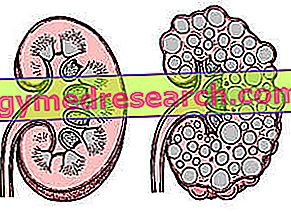Generality
The pulmonary artery is the large blood vessel that, originating from the right ventricle of the heart, initiates the transport of deoxygenated blood towards the lungs.

Approximately 3 centimeters wide, the pulmonary artery is divided, after a short path of 5 centimeters, into two smaller arteries: the right pulmonary artery, which is destined to flow into the right lung, and the left pulmonary artery, which is responsible for feeding the left lung.
The pulmonary artery can be the protagonist of a very serious morbid condition, fatal if not treated properly: pulmonary hypertension.
Short anatomical and functional revision of the heart
The heart is an unequal organ, hollow and predominantly of a muscular nature ( myocardium ), which is placed inside the thoracic cage, on the center-left.
Representing the most important organ of the circulatory system, the heart can be divided into two halves, the right half and the left half; in each half, two distinct cavities are recognizable, called the right atrium and right ventricle, with regard to the right cardiac half, and the left atrium and left ventricle, with regard to the left cardiac half.
Thanks to the activity of the cavities just mentioned, the heart first deals with oxygenating the blood in the lungs and then sending it to the various organs and tissues of the human body; specifically, the right atrium and right ventricle have the task of pumping blood into the lungs, while the left atrium and left ventricle have the important role of distributing blood to organs and tissues throughout the body.
It is important to note that the flow of blood entering and leaving the various cardiac cavities is under the control of 4 valves, called heart valves .
What is the Pulmonary Artery?
The pulmonary artery, or pulmonary trunk or main pulmonary artery, is the large blood vessel that originates in the right ventricle of the heart and has the task, with the help of its branches, of transporting oxygen-free blood to the lungs, for the oxygenation process.
The pulmonary artery is therefore a fundamental element of the cardiovascular system ; without it, in fact, the blood vessel would be missing which allows being a man to have oxygenated blood in a circle.
The blood that reaches the lungs, through the passage along the pulmonary artery and its branches, is the blood which, at the level of the pulmonary alveoli, exchanges carbon dioxide for the oxygen deriving from the respiratory process (pulmonary).
The pulmonary artery is an abnormal artery because ...
The common idea is that the arteries are the blood vessels responsible for transporting arterial blood or oxygenated blood and that the veins, instead, are the blood vessels deposited to transport the venous blood or deoxygenated blood (ie devoid of oxygen).
This view, however, is wrong and it is precisely the pulmonary artery, with its branches, that proves it. In fact, in the pulmonary artery and in its ramifications, only oxygen-free blood flows .
The anomalous behavior of the pulmonary artery with respect to all the blood vessels called arteries offers the opportunity to point out that, in anatomy, the true distinctive parameter between arteries and veins is the structure of these vascular elements (arteries and veins have walls with extremely characteristic features). different).
Did you know that ...
- The only other blood vessels that, although called arteries, carry venous blood are the umbilical arteries of the fetus . These arteries, however, exist only during prenatal life.
- Even between the veins there are vessels with different behavior from the canonical one (ie the transport of oxygen-free blood). The vessels in question are the so-called pulmonary veins, or rather the veins responsible for bringing back to the left heart the blood just passed through the lungs (therefore oxygenated).
- All the blood vessels that depart from the heart are arteries, while all the blood vessels that reach the heart are veins.
Anatomy
The pulmonary artery originates at the base of the right ventricle of the heart, exactly where the so - called pulmonary valve resides (one of the 4 heart valves). From here, it goes upwards, passing, first, anteriorly to the ascending branch of the aorta and, subsequently, to the left of the latter.
The pulmonary artery is a large but very short vessel; it measures, in fact, only 5 centimeters in length and a good 3 centimeters in diameter.
To mark the end of its short course is a clear branching, from which origin two arteries with opposite orientation (one is oriented to the right and one is oriented to the left), called right pulmonary artery and left pulmonary artery .
Although not entirely appropriate, it is common and accepted to refer to the pulmonary artery complex - right pulmonary artery - left pulmonary artery with the expression " pulmonary arteries ".
Left pulmonary artery
The left pulmonary artery is, as it can be easily guessed from the name, the branch of the pulmonary artery oriented to the left.
About 3 centimeters long and less than 2 centimeters wide, the left pulmonary artery follows an anterior path to the descending aorta, which leads it to flow into the left lung of the human body. Once in the left lung, it splits into two smaller arteries - called lobar arteries - one designed to reach the upper lobe of the left lung ( upper lobar artery ) and one designed to reach the lower lobe of the right lung ( lower lobar artery ).
From the single lobar arteries, therefore, a series of vascular branching system begins, culminating in the very small arterial vessels that surround the pulmonary alveoli and take oxygen in exchange for carbon dioxide.
Remember that ...
Unlike the human right lung which has 3 lobes (upper, intermediate and inferior), the human left lung has only two lobes.
Right pulmonary artery
The right pulmonary artery is obviously the branch of the pulmonary artery pointing to the right.
5-6 centimeters long and at least 2 centimeters wide, the right pulmonary artery follows a path that, before culminating with the entrance into the right lung, makes it pass under the aortic arch, behind the descending aorta, in front of the ascending aorta and, finally, behind the superior vena cava .

At the right lung, therefore, the right pulmonary artery is divided into two smaller branches: the anterior trunk and the interlobar artery . The anterior trunk is intended to reach the upper lobe of the right lung (in fact it corresponds to the lobar artery with the same function as the left lung), while the interlobar artery is designed to divide between the intermediate lobe and the lower lobe of the right lung.
At this point, exactly like the main branches of the left pulmonary artery (lobar arteries), also the two branches of the right pulmonary artery are the protagonists of a serial vascular branching system that ends with the small arterial vessels placed around the pulmonary alveoli and members of the oxygen-carbon dioxide exchange.
Pulmonary artery pressure
Measurable through a special catheter, the pressure inside the pulmonary artery oscillates, in a healthy subject, between 9 and 18 millimeters of mercury (mmHg).
Function
The pulmonary artery has the vital task of receiving the oxygen-poor blood, present in the right ventricle of the heart, and directing it, through its branches, towards the lungs, to oxygenate itself.
diseases
The pulmonary artery can be the protagonist of a very serious morbid condition, fatal if not properly treated: pulmonary hypertension .
What is pulmonary hypertension?
In medicine, the term "pulmonary hypertension" indicates an abnormal and persistent rise in blood pressure within the pulmonary artery (or one of its branches) and within the right cavities of the heart (ie atrium and right ventricle) .
Important
In order to talk about pulmonary hypertension, the blood pressure inside the pulmonary artery must be greater than 25 mmHg.
CAUSES
In general, pulmonary hypertension is caused by alteration of the pulmonary artery walls (or one of its branches), which causes the narrowing of the inner lumen of the latter. In other words, pulmonary hypertension occurs when the pulmonary artery (or its branching) is the victim of an alteration that causes it to shrink.
The possible causes of this restriction include:
- COPD;
- Thromboembolic disease;
- Pulmonary embolism;
- Heart failure;
- Pulmonary interstitial disease;
- The syndrome of obstructive sleep apnea;
- Alveolar hypoventilation;
- Sarcoidosis;
- Neurofibromatosis;
- Chronic renal failure;
- Vasculitis;
- Connective tissue diseases (eg: scleroderma, systemic lupus erythematosus, etc.);
- Sickle cell anemia.
SYMPTOMS
When the pressure inside the pulmonary artery increases abnormally and persistently, the typical symptoms are dyspnoea, chest pain, tachycardia, dizziness, lower limb edema, a sense of fainting, cyanosis and a sense of recurrent fatigue .
Possible complications of pulmonary hypertension:
|
DIAGNOSIS
In addition to the physical examination and anamnesis, to diagnose the abnormal increase in blood pressure in the pulmonary artery or in some of its branches, the following are indispensable: the right cardiac catheterization (which allows the measurement of blood pressure), the echocardiogram, spirometry and an analysis of lung perfusion.
THERAPY
The treatment of pulmonary hypertension varies from patient to patient, depending on what triggered the increase in pressure within the pulmonary artery.



